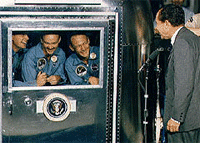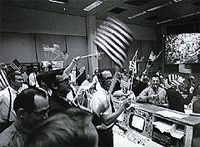
 |
| President Nixon congratulates the Apollo 11 astronauts, who are still in quarantine. (NASA) |
 |
| Celebration at Mission Control in Houston after the safe return of Apollo 11. (NASA) |
First Space Flights
On July 24, the capsule splashes down in the Pacific Ocean. The race to the moon is over. An aircraft carrier plucks Armstrong, Aldrin, and Collins from the ocean. President Nixon is onboard. He says, "This is the greatest week in the history of the world since creation. As a result of what you have done, the world has never been closer together." A Marine band plays "The Star-Spangled Banner."The astronauts watch everything from behind a little glass window. They are stuck in quarantine once again.
Mission Control fills with cigar smoke. Flight controllers wave flags. On the big screen it says, "Mission Accomplished."
After the parades and speeches, life quiets down. Armstrong stays with NASA for another year, then becomes a professor at the University of Cincinnati. In 1979, he leaves teaching to pursue business activities. In 1986, he serves on the commission to investigate the Challenger disaster.
After leaving NASA, Aldrin becomes Commander of the Air Force test pilot school in California. He retires from the Air Force in 1972 and begins writing books. He continues to look for better ways for humans to explore space.
Collins turns down the opportunity to go on another moon mission. Although he would have the chance to walk on the moon, he doesn't want to strain his family again. Instead, he takes a job as an Assistant Secretary of State. Then he becomes the first Director of the Smithsonian National Air and Space Museum. It opens in 1976, and includes his Apollo 11 Command Module.
The crew of Apollo 11 left a plaque on the Moon. It reads: "We came in peace for all mankind." Aldrin says, "I hope some wayward stranger in the third millennium may read it and say, 'This is where it all began.'"
After Apollo 11, five more Apollo missions land on the moon. The space race is over. America won. Even so, space exploration has barely begun.



